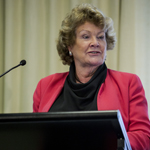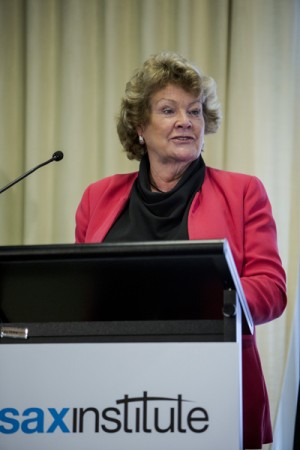

Event wrap: 26 November 2016.
An average of one new piece of research made possible by the Sax Institute’s 45 and Up Study is now published each week in a peer-reviewed journal, furthering knowledge about the health of our ageing population, the Study’s annual meeting has been told.
The meeting, which attracted a record 170 participants, showcased the latest findings from Australia’s biggest longitudinal health study which has now been providing data on the health of 260,000 NSW men and women aged over 45 years for over a decade.
Some of the diverse findings presented at the meeting, held in Sydney, included a study on the positive health effects of retirement, analysis of the burden of gastrointestinal infection in the elderly and research into the mortality risk associated with fractures.
Exciting future directions for the Study were also revealed, including:
- Its use to help create the world’s largest public genome database, the Garvan Institute’s Medical Genome Reference Bank, which will drive cutting-edge research into conditions like diabetes and cancer
- Its use in a $6.5 million world-first trial into modifiable risk factors for dementia
- Its use by Cancer Council NSW to build predictive models on the risk of disease that will help determine where to intervene for prevention and early detection of diseases such as lung and prostate cancer.
Health Minister outlines study value
Opening the meeting, NSW Health Minister Jillian Skinner said the NSW Government recognised the enormous value of big data, such as the 45 and Up Study, to health and medical research.
“In this era of big data, where governments are considering how to use the information they already have to plan better services and improve population health, the Study gives us a way in to the picture, allowing us to join the dots between the rich detail of people’s backgrounds and experiences, and the information collected by the system such as admissions to hospital,” she said.
She added: “The 45 and Up Study provides us with research advances that people in other parts of the world would envy.”
An incredibly rich resource
Study Scientific Director Professor Emily Banks, who described the Collaborators’ meeting as her “favourite day of the year”, outlined some of the Study’s achievements to date including:
- 128 projects involving the Study have or are being conducted
- 13 sub-studies have been undertaken or are underway and three more are planned
- 580 researchers across 75 organisations have used the Study
- 27 policy agencies have used the Study
- 170 peer-reviewed papers have been published. Fifty studies are now being published each year – about one per week.
- 47 grants have been awarded, worth about $29 million
Professor Banks said the study was now linked with a growing number of data sets, including 42 million MBS and PBS records.
“It is becoming an incredibly rich resource,” she said.
Policy hunger for findings
There was also a growing “policy hunger” for the findings from the study, she said, citing the example of her influential study findings on smoking published earlier this year, that revealed up to two in three Australian smokers will die from their habit if they continue to smoke.
The research attracted more than 900 media reports and gained international attention, she said, and the findings were now being used to help spread the anti-smoking message by both government and non-government agencies including Quitline, the Australian Council on Smoking and Health (ACOSH) and the Tobacco Free Investment Initiative.
“It has had impact in the way that people perceive the risks of smoking, and that has been very heartening,” Professor Banks said.
Future opportunities
Study Director Ms Margo Barr said future opportunities for the 45 and Up Study included exploring more linkage possibilities, improving the timeliness of linked data, the use of Study specimens in the Medical Genome Reference Bank and the facilitation of remote, secure data linkage through the Sax Institute’s SURE (Secured Unified Research Environment) facility.
The 45 and Up Study is managed by the Sax Institute in partnership with major partner Cancer Council NSW and partners: the National Heart Foundation of Australia (NSW Division); NSW Ministry of Health; NSW Government Family & Community Services – Carers, Ageing and Disability Inclusion; and the Australian Red Cross Blood Service.
Find out more
- Find out more about the 45 and Up Study
- Read other items in our news wrap from the meeting
- View the photo gallery from the day
- Read about Professor Emily Banks’ findings on smoking
- Find out more about SURE, the Secure Unified Research Environment.
